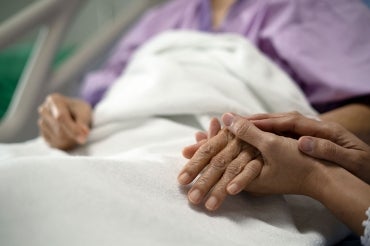Historical study suggests link between institutionalization, hip fractures and death

(photo by Sukanya Sitthikongsak/Getty Images)
Published: September 1, 2023
A team of anthropologists has found that the skeletal remains of people who lived and died in American public care institutions in the last century have much to tell us about the connection between patient neglect and hip fractures – a connection that may still exist today in Canada.
Using paleopathology – the study of disease in the past using sources including human remains – the three researchers studied individuals who lived in state hospitals, city infirmaries and other public institutions in Missouri and who died between 1910 and 1967.
They found evidence of hip fractures in 4.3 per cent of institutionalized individuals, almost double the 2.3 per cent prevalence among non-institutionalized people. Death records showed that many of these broken hips occurred from preventable accidents, including falling out of a wheelchair, tripping on an uneven floor, slipping in a bathtub or being pushed to the ground (most hip fractures need quick medical intervention to prevent deadly complications.)
“These folks were living in institutions that were supposedly caring for them,” says Madeleine Mant, assistant professor in the University of Toronto Mississauga's department of anthropology and an author of the study, which was recently published in the journal PLOS One. “But ultimately the lack of care or the lack of resources or the lack of attention has created instances where they actually suffered fractures that led to their deaths.”
With colleagues Carlina de la Cova, of the University of South Carolina in Columbia, and Megan Brickley of McMaster University in Hamilton, Ont., Mant had access to a large anatomical skeletal collection housed at the Smithsonian National Museum of Natural History in Washington, D.C. These were people unclaimed after death – either because they were alone in the world, their loved ones were too poor to afford a burial or their families simply weren’t informed of their passing.
The 600 individuals in the study included Euro-American and African-American women and men in their 40s through 90s. More than one-third had been institutionalized.
In both cohorts, older white women showed the greatest prevalence of hip trauma. But the finding that was most critical – and, for Mant, the most disturbing – was that of the instances of broken hips leading to death, 82 per cent of incidents happened in institutions.
“That’s what struck me the hardest – the idea that these vulnerable individuals were taken in by institutions that were obviously underfunded and understaffed and that undervalued the lives of these folks.”
Mant points to two explanations. The first is structural violence, a term describing the way social structures and institutions cause harm to people through inequities and marginalization. In the case of the institutions being studied, this could include underfunding, overcrowding, poorly trained staff and poorly maintained facilities. The second is cultural apathy, which means society doesn’t care enough to rise up, speak out and demand change.
While anthropologists look at the past to better understand the present, Mant says in this case it’s less an echo and more a direct line to what we’re seeing today in many care institutions in Canada. She says that whenever she talks about her research, people will tell her about an aunt, a grandparent or other family member who suffered a hip fracture while in care.
“This is not just a historical story, and it’s not just an American story,” Mant says. “It’s an ongoing modern concern and it seems to be, unfortunately, global.”
Other studies from the Netherlands and Switzerland have also shown a disturbingly high risk of fractures among institutionalized people. Mant’s study includes a mention of a Canadian news story that made headlines last year: a woman in an Oakville, Ont., nursing home had major spiral fractures in both thigh bones when she died, but staff seemed to know nothing about it.
Mant hopes the study will help increase awareness and encourage those making public policy to treat equitable care of institutionalized people as a basic human right.
“We need to be taking care of our most vulnerable, bring this to people’s minds who might not have been aware of it and, honestly, shame people who have known about these problems and haven’t done anything so far,” she says.


